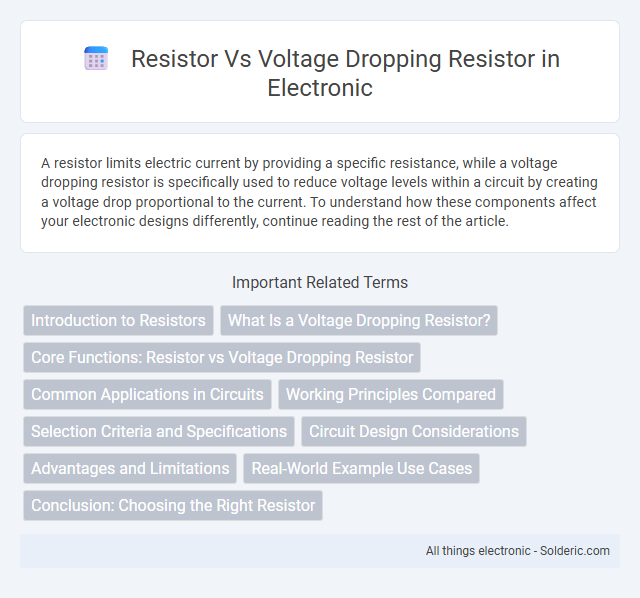A resistor limits electric current by providing a specific resistance, while a voltage dropping resistor is specifically used to reduce voltage levels within a circuit by creating a voltage drop proportional to the current. To understand how these components affect your electronic designs differently, continue reading the rest of the article.
Comparison Table
| Feature | Resistor | Voltage Dropping Resistor |
|---|---|---|
| Primary Function | Limits electric current in a circuit | Reduces voltage to a desired level |
| Usage | General current limiting, biasing, and signal conditioning | Power supply circuits for low voltage devices |
| Power Dissipation | Depends on circuit design | Typically higher due to voltage drop and power loss |
| Voltage Regulation | Does not regulate voltage precisely | Provides approximate voltage drop, not stable under varying load |
| Application Example | Current limiting for LEDs, load resistors | Voltage dropping for LEDs when no regulated supply available |
| Efficiency | Varies with usage | Less efficient, energy lost as heat |
Introduction to Resistors
A resistor is a passive electrical component designed to limit or regulate the flow of electric current in a circuit by providing a specific amount of resistance, measured in ohms (O). A voltage dropping resistor is a specific type of resistor used to reduce voltage levels within a circuit to safe or desired values by creating a voltage drop proportional to the current flowing through it, based on Ohm's Law (V=IR). While all voltage dropping resistors are resistors, not all resistors are used for voltage dropping purposes, as resistors serve various roles including current limiting, signal conditioning, and heat dissipation.
What Is a Voltage Dropping Resistor?
A voltage dropping resistor is a specific type of resistor designed to reduce voltage levels within a circuit by dissipating excess electrical energy as heat. Unlike standard resistors that primarily limit current, voltage dropping resistors are strategically selected to achieve a precise voltage reduction, ensuring other components receive the correct operating voltage. If you're designing or troubleshooting electronics, understanding how your voltage dropping resistor affects voltage distribution is crucial for optimal circuit performance.
Core Functions: Resistor vs Voltage Dropping Resistor
A resistor primarily limits electric current and divides voltage within circuits, ensuring components operate safely by controlling current flow. A voltage dropping resistor specifically reduces voltage to a desired level by dissipating excess power as heat, crucial in applications where precise voltage regulation is needed without complex circuitry. While both serve to manage electrical parameters, voltage dropping resistors are optimized for maintaining stable voltage levels in power supply and LED circuits.
Common Applications in Circuits
Resistors serve as fundamental components in circuits to control current flow, set biasing conditions, and divide voltages, making them essential in applications like signal conditioning and current limiting. Voltage dropping resistors specifically manage excess voltage by dissipating power to achieve the desired voltage level for sensitive components, commonly used in LED circuits and power supply regulation. Your choice between a general resistor and a voltage dropping resistor depends on the precision of voltage control and power dissipation requirements in the specific circuit application.
Working Principles Compared
A resistor regulates current flow by providing a fixed resistance, converting electrical energy into heat based on Ohm's Law, thereby controlling circuit performance. A voltage dropping resistor specifically reduces voltage within a circuit by creating a voltage drop proportional to the current, enabling devices to operate at safe voltage levels. Understanding your circuit's voltage requirements ensures the correct resistor type is selected for effective voltage regulation and component protection.
Selection Criteria and Specifications
Resistors are selected based on parameters like resistance value, power rating, tolerance, and temperature coefficient, ensuring they meet circuit requirements for voltage and current control. Voltage dropping resistors specifically require precise calculation of voltage drop, power dissipation, and load current to prevent overheating and maintain stable voltage levels. Key specifications include resistance stability under load, maximum power rating, and thermal resistance to ensure efficient voltage regulation and circuit protection.
Circuit Design Considerations
Choosing between a resistor and a voltage dropping resistor in circuit design hinges on power dissipation and voltage regulation requirements. A voltage dropping resistor must be carefully sized based on the load current and voltage difference to ensure stable output voltage without excessive heat generation. You should analyze the resistor's power rating to prevent thermal failure and maintain circuit efficiency.
Advantages and Limitations
A resistor provides basic current limiting and voltage control in circuits, offering simplicity and low cost but lacks precise voltage regulation under varying load conditions. Voltage dropping resistors are specifically used to reduce voltage levels by converting excess voltage into heat, making them suitable for low-power applications but inefficient for high-power circuits due to energy loss and heat dissipation. While resistors enable straightforward design implementations, their limitations in maintaining stable voltage under fluctuating loads necessitate alternative solutions like voltage regulators for sensitive electronics.
Real-World Example Use Cases
Resistors are commonly used in electronic circuits to control current flow and divide voltage, such as in LED indicator circuits where standard resistors limit current to prevent damage. Voltage dropping resistors specifically serve to reduce voltage to a desired level for components that require lower voltage, exemplified by their use in powering small sensors from higher voltage supplies, like dropping 12V to 5V. In automotive applications, voltage dropping resistors protect sensitive electronics by stepping down voltage from 24V systems to 12V or lower levels compatible with control modules.
Conclusion: Choosing the Right Resistor
Selecting the right resistor involves understanding its role in controlling current and voltage within a circuit. A standard resistor primarily limits current, while a voltage dropping resistor is specifically chosen to reduce voltage to a desired level for sensitive components. Your choice should be based on the precise voltage and current requirements to ensure optimal circuit performance and component protection.
resistor vs voltage dropping resistor Infographic

 solderic.com
solderic.com